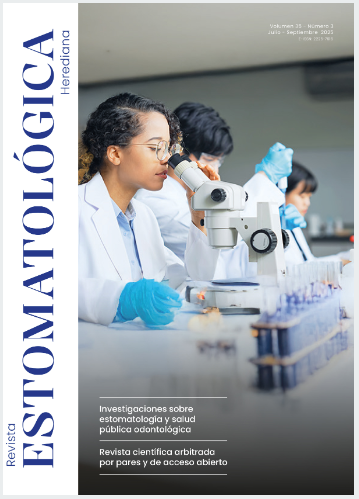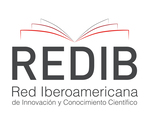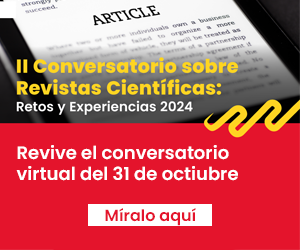Association between the position of impacted third molars and external root resorption of adjacent second molars observed through cone-beam computed tomography
DOI:
https://doi.org/10.20453/reh.v35i3.6723Keywords:
root resorption, impacted tooth, third molar, cone-beam computed tomographyAbstract
Objective: To determine the association between the position of impacted third molars and root resorption of adjacent second molars observed through cone-beam computed tomography in patients who attended a dental teaching center in Lima, Peru. Materials and methods: A cross-sectional, retrospective, and observational study was conducted on 84 cone-beam computed tomography (CBCT) scans that met the selection criteria, evaluating 153 impacted third molars according to Winter’s classification and their respective adjacent second molars. Results: Impacted third molars were found predominantly among women (57.1%; n = 48) and in patients aged 16 to 25 (59.5%; n = 50), with a predominance of the mesioangular position (77.8%; n = 119) and mandibular location (81.0%; n = 124). External root resorption of the second molar was observed in 13.1% (n = 20) of the total cases, mostly in women (70.0%; n = 14) and in patients aged 16 to 25 (60.0%; n = 12). The most frequent location was the cervical third (60.0%; n = 12), and the degree of resorption was mostly mild (80.0%; n = 16). A statistically significant association was observed between impacted third molars and external root resorption of the adjacent second molar (p < 0.001), as well as between the latter and the position of the impacted third molar (p = 0.002). Conclusions: There is an association between the position of the impacted third molar and root resorption of adjacent second molars, with the mesioangular position presenting the highest risk.
Downloads
References
Haddad Z, Khorasani M, Bakhshi M, Tofangchiha M, Shalli Z. Radiographic position of impacted mandibular third molars and their association with pathological conditions. Int J Dent [Internet]. 2021; 2021: 8841297. Disponible en: https://doi.org/10.1155/2021/8841297
Choi J. Risk factors for external root resorption of maxillary second molars associated with third molars. Imaging Sci Dent [Internet]. 2022; 52(3): 289-294. Disponible en: https://doi.org/10.5624/isd.20220401
Prasanna Kumar D, Sharma M, Vijaya Lakshmi G, Subedar RS, Nithin VM, Patil V. Pathologies associated with second mandibular molar due to various types of impacted third molar: a comparative clinical study. J Maxillofac Oral Surg [Internet]. 2022; 21(4): 1126-1139. Disponible en: https://doi.org/10.1007/s12663-021-01517-0
Skitioui M, Jaoui D, Haj Khalaf L, Touré B. Mandibular second molars and their pathologies related to the position of the mandibular third molar: a radiographic study. Clin Cosmet Investig Dent [Internet]. 2023; 15: 215-223. Disponible en: https://doi.org/10.2147/CCIDE.S420765
Velickovic S, Zivic M, Rajkovic Z, Stanisic D, Misic A, Vasovic M. Analysis of external root resorption of the second molar associated with an impaction of the third molar by the application of CBCT. Exp Appl Biomed Res [Internet]. 2021; 22(4): 343-349. Disponible en: https://doi.org/10.2478/sjecr-2019-0053
Sakhdari S, Farahani S, Asnaashari E, Marjani S. Frequency and severity of second molar external root resorption due to the adjacent third molar and related factors: a cone-beam computed tomography study. Front Dent [Internet]. 2021; 18: 36. Disponible en: https://doi.org/10.18502/fid.v18i36.7561
Smailienė D, Trakinienė G, Beinorienė A, Tutlienė U. Relationship between the position of impacted third molars and external root resorption of adjacent second molars: a retrospective CBCT study. Medicina [Internet]. 2019; 55(6): 305. Disponible en: https://doi.org/10.3390/medicina55060305
Suter VG, Rivola M, Schriber M, Leung YY, Bornstein MM. Risk factors for root resorption of second molars associated with impacted mandibular third molars. Int J Oral Maxillofac Surg [Internet]. 2019; 48(6): 801-809. Disponible en: https://doi.org/10.1016/j.ijom.2018.11.005
Tassoker M. What are the risk factors for external root resorption of second molars associated with impacted third molars? A cone-beam computed tomography study. J Oral Maxillofac Surg [Internet]. 2019; 77(1): 11-17. Disponible en: https://doi.org/10.1016/j.joms.2018.08.023
Elkassas R, Eiid S, El Beshlawy D. Frequency of external root resorption in mandibular second molars associated with mandibular impacted third molars in a sample of Egyptian population using CBCT: a cross-sectional study. Egypt Dent J [Internet]. 2022; 68(1): 323-329. Disponible en: https://doi.org/10.21608/edj.2021.89726.1740
Lacerda-Santos JT, Granja GL, Bento PM, Araújo-Filho JCWP, Melo DP, Santos JA. Prevalence of second molar external root resorption caused by mandibular third molars: a CBCT study. Gen Dent [Internet]. 2023; 71(1): 58-63. Disponible en: https://pubmed.ncbi.nlm.nih.gov/36592361/
Yesiltepe S, Kılcı G. Evaluation the relationship between the position and impaction level of the impacted maxillary third molar teeth and marginal bone loss, caries and resorption findings of the second molar teeth with CBCT scans. Oral Radiol [Internet]. 2022; 38(2): 269-277. Disponible en: https://doi.org/10.1007/s11282-021-00554-2
Keskin S, Koc A. Evaluation of risk factors for external root resorption and dental caries of second molars associated with impacted third molars. J Oral Maxillofac Surg [Internet]. 2020; 78(9): 1467-1477. Disponible en: https://doi.org/10.1016/j.joms.2020.04.041
Li D, Tao Y, Cui M, Zhang W, Zhang X, Hu X. External root resorption in maxillary and mandibular second molars associated with impacted third molars: a cone-beam computed tomographic study. Clin Oral Investig [Internet]. 2019; 23(12): 4195-4203. Disponible en: https://doi.org/10.1007/s00784-019-02859-3
Moreira-Souza L, Oliveira LB, Gaêta-Araujo H, Almeida-Marques M, Asprino L, Oenning AC. Comparison of CBCT and panoramic radiography for the assessment of bone loss and root resorption on the second molar associated with third molar impaction: a systematic review. Dentomaxillofac Radiol [Internet]. 2022; 51(3): 20210217. Disponible en: https://doi.org/10.1259/dmfr.20210217
Naik V, Prakash S, Chuan NW, Nishanthisri, Ying OC. Frequency of recommending cone beam computed tomography in comparison to panoramic radiograph, while diagnosing a pathology/status of vital structures around mandibular impacted third molar. J Indian Acad Oral Med Radiol [Internet]. 2022; 34(3): 314-319. Disponible en: https://doi.org/10.4103/jiaomr.jiaomr_156_21
Gürses G, Akçakaya A, Aktı A, Aydin O. The effect of impacted third molars on second molar external root resorption, a cross-sectional cone beam computed tomography study. Med Oral Patol Oral Cir Bucal [Internet]. 2023; 28(6): e504-e511. Disponible en: https://doi.org/10.4317/medoral.25860
Al-Khateeb TH, Bataineh AB. Pathology associated with impacted mandibular third molars in a group of jordanians. J Oral Maxillofac Surg [Internet]. 2006; 64(11): 1598-1602. Disponible en: https://doi.org/10.1016/j.joms.2005.11.102
Ericson S, Bjerklin K, Falahat B. Does the canine dental follicle cause resorption of permanent incisor roots? A computed tomographic study of erupting maxillary canines. Angle Orthod [Internet]. 2002; 72(2): 95-104. Disponible en: https://angle-orthodontist.kglmeridian.com/view/journals/angl/72/2/article-p95.xml
Winter GB. Impacted Mandibular Third Molar. St. Louis: American Medical Book; 1926.
García-Lallana A, Viteri-Ramírez G, Saiz-Mendiguren R, Broncano J, Dámaso J. Ergonomía del puesto de trabajo en radiología. Radiología [Internet]. 2011; 53(6): 507-515. Disponible en: https://doi.org/10.1016/j.rx.2011.06.007
Deliga ÂG, Westphalen FH, Schröder JC, Fernandes Â, Westphalen VP. Accuracy of digital periapical radiography and cone-beam computed tomography for diagnosis of natural and smulated external root resorption. J Endod [Internet]. 2018; 44(7): 1151-1158. Disponible en: https://doi.org/10.1016/j.joen.2018.03.011
Palomares SL, Serna MK, Manrique K. Posición de impactación de terceros molares en adultos peruanos. Kiru [Internet]. 2021; 18(3): 153-159. Disponible en: https://doi.org/10.24265/kiru.2021.v18n3.04
Gebeyehu T, Abaynew Y. Prevalence and patterns of third molar impaction among Ethiopians in Addis Ababa: a retrospective pilot study. Sci Rep [Internet]. 2024; 14: 8952. Disponible en: https://doi.org/10.1038/s41598-024-59821-x
Hashemipour MA, Tahmasbi-Arashlow M, Fahimi-Hanzaei F. Incidence of impacted mandibular and maxillary third molars: a radiographic study in a Southeast Iran population. Med Oral Patol Oral Cir Bucal [Internet]. 2013; 18(1): e140-e145. Disponible en: https://doi.org/10.4317/medoral.18028
González L. Características anatomorradiográficas de los terceros molares en adolescentes de la enseñanza preuniversitaria. Rev Cubana Estomatol [Internet]. 2019; 56(2): e1722. Disponible en: http://www.scielo.sld.cu/scielo.php?script=sci_arttext&pid=S0034-75072019000200005
Hesam A, Samimi SM, Ghorbani R. Molar impaction patterns and skeletal malocclusions. J Craniomax Res [Internet]. 2022; 8(4): 178-186. Disponible en: https://doi.org/10.18502/jcr.v8i4.11072
Passi D, Singh G, Dutta S, Srivastava D, Chandra L, Mishra S, et al. Study of pattern and prevalence of mandibular impacted third molar among Delhi-National capital region population with newer proposed classification of mandibular impacted third molar: a retrospective study. Natl J Maxillofac Surg [Internet]. 2019; 10(1): 59-67. Disponible en: https://doi.org/10.4103/njms.NJMS_70_17
Alfadil L, Almajed E. Prevalence of impacted third molars and the reason for extraction in Saudi Arabia. Saudi Dent J [Internet]. 2020; 32(5): 262-268. Disponible en: https://doi.org/10.1016/j.sdentj.2020.01.002
Kou Z, Zhang W, Li C, Zhang Y, Song Z, Zou Y, et al. A prediction model for external root resorption of the second molars associated with third molars. Int Dent J [Internet]. 2025; 75(1): 195-205. Disponible en: https://doi.org/10.1016/j.identj.2024.09.031
Downloads
Published
How to Cite
Issue
Section
License
Copyright (c) 2025 Jenny Teresa Atuncar Salazar, Vilma Elizabeth Ruiz Garcia de Chacon

This work is licensed under a Creative Commons Attribution 4.0 International License.
The authors retain the copyright and cede to the journal the right of first publication, with the work registered with the Creative Commons License, which allows third parties to use what is published as long as they mention the authorship of the work, and to the first publication in this journal.























